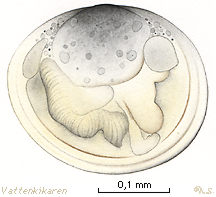 |
 |

 Distribution in scandinavian waters |
Maximum length: It is difficult finding
information about the maximum size of mussel veliger, but you can compare
the above larva with a hair. Appearance: Mussel veliger carries two thin transparent shells and they have a large cirria furnished indentation known as the velum. While they rest as in the picture above, they pull in their velum between the two shell halves, but when they swim, the cirria are easily seen. Compare the mussel veliger with the snail veliger. Depth: From sea level to unknown depth. Environment: Pelagic. Misc: When the eggs from many different specie hatch in the sea, larvae appear. During this first stage of development they seldom resemble their parents in appearance or life style. Many mussels go through two larva stages; during the first stage they are known as trochophora larvae, later they develope into mussel veliger. The common mussel for example has two pelagic larva stages, while with the oyster, the larva has reached the veliger stage before the female releases the larva into the water. During the summer and autumn, mussel veliger dominate to such an extent so that other veliger are difficult to see. The time spent as a larva can vary greatly between the different specie, from a few minutes to several months. The larvae live off the nutrients in the egg and other small organisms in the water. Food is caught, transported and sorted by the velum at the same time as it is used for swimming. Many larvae are eaten by suspension feeders. Classification: Mussel veliger are members of the mussel group under the molluscs. |